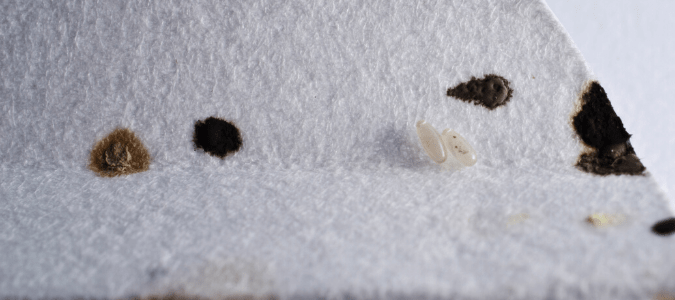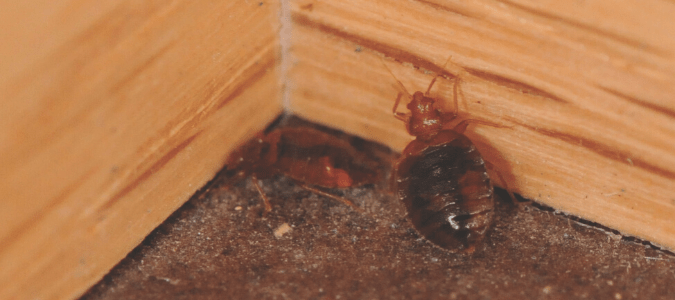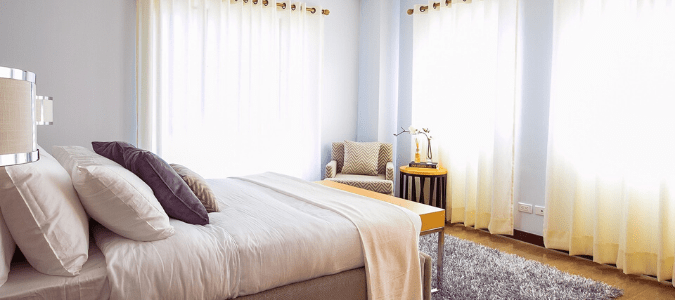
You’ve found strange black spots in your bed—dots about the size of poppy seeds, some of which might bleed like a spot of ink on the fabric of your sheets, pillows or mattress. When you go through all the possibilities, you might have wondered whether what you have seen is bed bug feces.
If you’ve noticed these tiny black spots, and especially if you also have itchy bites anywhere on your body, bed bugs are a very real possibility. Bed bugs are feared by many for good reason and, unfortunately, these tiny pests can infest even the cleanest of homes. While anyone can fall victim to a bed bug problem, they are a particular risk in the homes of people who travel a lot or who frequent garage sales and thrift shops. Traveling and acquiring second-hand furniture and other used items are two activities that could lead to inadvertently bringing home tiny, highly unwelcome hitchhikers—bed bugs. Once inside your home, these pests could infest your bed or other areas and make your life miserable.
Bed bugs are small, flat, oval-shaped and medium to dark brown in color—about the size, shape and color of apple seeds. These parasites feed on human blood, usually under the cover of darkness, which is why they tend to be more concentrated near areas where humans go when it’s dark—namely, our beds.
Since these creatures feed on blood, their feces is dark in color, as it is made up of digested, dried blood. That’s why finding black spots on your bed, couch or other pieces of furniture could indicate that you have a bed bug infestation—but it could also be a sign of something else, such as fleas. In fact, the National Pest Management Association’s 2018 Bugs Without Borders survey found that 84% of calls fielded by professionals about other pests actually ended up being for bed bugs, with fleas being the most common pest confused with these creatures. Flea excrement is often called flea dirt because it looks like tiny black specks of dirt or dust. If you have a dog or cat that spends time in your bed and might have fleas, it’s possible that they are the source of your little black spots. A professional exterminator can inspect the area and determine what type of pest you’re dealing with and how to treat the problem.
Unlike flea excrement, bed bug feces are often found grouped in small clusters, and often along the seams of mattresses or other furniture. This is because bed bugs hide in tiny spaces where they can stay out of sight. They might tuck themselves against the piping that runs along the edge of a mattress or the back of an easy chair, to stay protected until they can safely venture out once again for a blood meal.
Bed bugs don’t restrict themselves only to beds, however. They can also infest sofas and other furniture, and they sometimes retreat to other spaces during daylight hours, such as on the wall near the bed, behind the headboard, behind a picture hanging on the wall or along the back of a piece of furniture that’s pushed against the wall. Bed bugs can even hang out inside your dresser drawers. These pests have even been found in carpets and between floorboards, where they wait until it’s time to feed again.
Along with finding these tiny, dark spots, here are some other indications of a bed bug infestation:
- Small, reddish-brown or rust-colored spots on your sheets or pillow. These could be dried blood spots that occurred when a bed bug was crushed post-feeding.
- Itchy bites on your body that may be grouped in lines or clusters. Depending on your reaction to these bites, they might be raised or even form tiny blisters.
- Actual bed bugs, alive or dead, or their nymphs, eggs or exoskeletons. Adult bed bugs are brown, oval-shaped and about a quarter-inch long. Nymphs are tiny and whitish or pale brown in color. Bed bug eggs are also tiny, whitish and translucent. Both nymphs and eggs are difficult to spot, since they are so small. Adult bed bugs and the exoskeletons that they shed from time to time are easier to see if you know where to look.
Trying to address a bed bug infestation on your own can be an emotionally draining, time-consuming and often ultimately fruitless endeavor, especially because these pests can go for several months without feeding and can fit into the tiniest spaces across your home. Many people who attempt DIY elimination efforts wish they had gotten professional help from a pest control specialist earlier, since these technicians are specially trained in how to address an infestation by targeting all stages of the bug’s life cycle. However you choose to tackle your bed bug problem, remember that it’s important to consider not just adult bed bugs but their eggs and nymphs as well.
Unfortunately, even once bed bugs and their eggs have been killed off, their remaining feces can still cause problems for the people living in the home. Bed bug feces has been found to contain histamines that can cause allergic reactions in humans, including itchiness and breathing problems. This means that even once you get rid of the bugs themselves, you could still suffer until you thoroughly clean the walls, furniture, floor, upholstery and any other areas where these pests spent time when they were infesting your home. You might even need to get rid of some items altogether and purchase new ones.
If you are in the process of dealing with a bed bug infestation, you likely have additional questions about these pests. For example, you may wonder if bed bugs gravitate toward certain materials and environments. You’re probably also curious as to how you got a bed bug infestation in the first place. We’ll address these questions so you have the best information about what to do next if you suspect you have a problem.

Can Bed Bugs Live In Wood?
Perhaps because the name of these pests suggests that they live exclusively in people’s beds, many people assume that they won’t find bed bugs anywhere but in the bed. However, bed bugs can also live in other areas of the home. These pests can live in and around sofas and chairs, for example, since these are places where people spend lots of time.
During daylight hours, bed bugs tend to hide in the smallest cracks and crevices and wait until the next time they can safely come out of hiding for another blood meal. These pests, and their nymphs and eggs, have been found on the backs of wooden headboards and dressers that are pushed against the wall, as well as in the cracks between wooden floorboards. They have even been found inside wooden drawers, especially if they traveled there on clothing that was stored in the drawers.
Bed bugs hide out in these spaces because they are relatively protected from view, and in that sense, they certainly can live in wood. While a bed bug can live for months without eating, they must eventually emerge to feed on their human hosts. Since humans typically prefer to rest or sleep on soft, fabric-covered furniture, like beds, sofas or easy chairs, rather than on hard wooden surfaces, bed bugs typically gravitate to those spaces as well. Bed bugs have even been found in stuffed animals, bedside lamps and wheelchairs. It’s all about easy access to the blood they depend on to survive.
If you’re dealing with a bed bug infestation and you’ve found evidence of bed bugs in your bed, you may wonder if you should dismantle your entire bed frame and treat it in some specialized way to get rid of every last bed bug. Since bed bugs can spend extended periods of time hidden in bed frames and other wooden spaces, and since they might also lay their eggs in these spaces, if you think you may have bed bugs, you should definitely perform an inspection for evidence of bed bugs in your bed frame and other areas, and not just on your mattress itself.
If you’ve spotted some type of insect or eggs in your furniture, baseboards or some other wooden item in your home, you could be dealing with bed bugs. Or, you could be dealing with a bug that looks like a bed bug, such as drywood termites or some other type of pest. Your best bet for peace of mind and to quickly begin treatment is to contact a pest control professional. These specialists are experienced in conducting thorough inspections to determine which type of pest is present and what the best course of treatment might be. Professional exterminators also know exactly where to look for bed bugs in all stages of their life cycle and the best way to resolve your infestation as quickly as possible so that your life will no longer be disrupted.

What Attracts Bed Bugs?
Many people wonder how they got bed bugs and what attracts these pests to a certain home or area of the home. Or, on a related note, you may ask yourself a few other questions, including: Where did these bed bugs come from? Are they more likely to infest messy or dirty homes? Can keeping an impeccably clean house protect you against these pests? Unfortunately, bed bugs are equal opportunity pests—meaning, they will happily live, feed and lay eggs anywhere humans are. They have adapted to withstand a large temperature range, from around freezing to up to 122 degrees Fahrenheit, making them well suited to life indoors. Unfortunately, this means your home is vulnerable to bed bugs, no matter how clean it may be.
Bed bugs don’t just infest homes at random, however; they have to be brought in from somewhere else. They act as hitchhikers, usually coming in on the luggage of travelers who stayed in a hotel or other area that had a bed bug infestation or second-hand furniture or clothing purchased at a thrift store or yard sale.
This is why it’s wise to look for any signs of bed bugs when you begin your stay in a hotel room, choose a seat on a bus or bring home a used item of furniture or clothing. When you’re traveling, you can take extra precautions to avoid bring home these pests by keeping your items in your bags rather than dresser drawers and using luggage racks to keep your items off the floor if possible. You can perform an inspection by pulling back the sheets before using the bed to look for any of the above-mentioned signs of bed bugs. You may want to use the flashlight on your phone to illuminate some areas. You can also inspect second-hand furniture, clothing and rugs for the same signs, so you can to everything you can to prevent bringing home unwanted pests and having to deal with an infestation.
If you think you may have bed bugs, it’s wise to reach out to a pest control specialist as soon as possible to address the problem. These pests are notorious for being extremely difficult to eradicate, and DIY methods are often ineffective, only serving to prolong the agony of a problem. Effective bed bug treatment must address all stages of their life cycle and must be comprehensive and thorough.
ABC Can Handle Your Bed Bug Problem
Having bed bugs in your home can take a huge emotional toll on you and your family members. Between the lack of sleep, psychological effects and itchy bites, having bed bugs are no picnic. Most homeowners who have been victims to an infestation wish they had contacted a professional earlier to deal with this type of infestation. Fortunately, the pest experts at ABC Home & Commercial Services are well-versed on bed bug hiding spots and behavior, and can create a thorough, customized solution for your problem. With ABC’s help, you and your family will sleep easy again.
